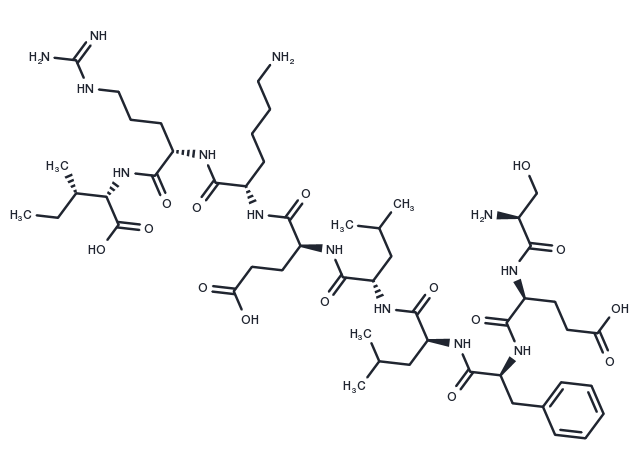keep away from moisture
Powder: -20°C for 3 years | In solvent: -80°C for 1 year

Large T antigen - rhesus polyomavirus 560-568 has a peptide sequence of Ser-Glu-Phe-Leu-Leu-Glu-Lys-Arg-Ile. T antigen is required for viral DNA replication, transcription, and virion assembly.

| Pack Size | Availability | Price/USD | Quantity |
|---|---|---|---|
| 1 mg | Inquiry | $ 50.00 | |
| 5 mg | Inquiry | $ 143.00 | |
| 10 mg | Inquiry | $ 235.00 | |
| 25 mg | Inquiry | $ 329.00 |
| Description | Large T antigen - rhesus polyomavirus 560-568 has a peptide sequence of Ser-Glu-Phe-Leu-Leu-Glu-Lys-Arg-Ile. T antigen is required for viral DNA replication, transcription, and virion assembly. |
| In vitro | In addition, the T antigen targets multiple cellular pathways, including those that regulate cell proliferation, cell death, and the inflammatory response. The large T-antigen plays a key role in regulating the viral life cycle by binding to the viral origin of DNA replication where it promotes DNA synthesis. Also as the polyomavirus relies on the host cell machinery to replicate the host cell needs to be in s-phase for this to begin. Due to this, large T-antigen also modulates cellular signaling pathways to stimulate the progression of the cell cycle by binding to a number of cellular control proteins. |
| In vivo | Polyomaviruses have been extensively studied as tumor viruses in humans and animals, leading to fundamental insights into carcinogenesis, DNA replication, and protein processing. The tumor suppressor molecule p53 was discovered, for example, as a cellular protein bound by the major oncoprotein (cancer-causing protein) T antigen made by Simian vacuolating virus 40 (SV40). |
| Molecular Weight | 1134.33 |
| Formula | C52H87N13O15 |
| CAS No. | TP2183 |
keep away from moisture
Powder: -20°C for 3 years | In solvent: -80°C for 1 year
DMSO: ≥113.4mg/mL
You can also refer to dose conversion for different animals. More
bottom
Please see Inhibitor Handling Instructions for more frequently ask questions. Topics include: how to prepare stock solutions, how to store products, and cautions on cell-based assays & animal experiments, etc.
Large T antigen - rhesus polyomavirus 560-568 TP2183 Others Large T antigen rhesus polyomavirus 560568 Large T antigen rhesus polyomavirus 560 568 inhibitor inhibit
